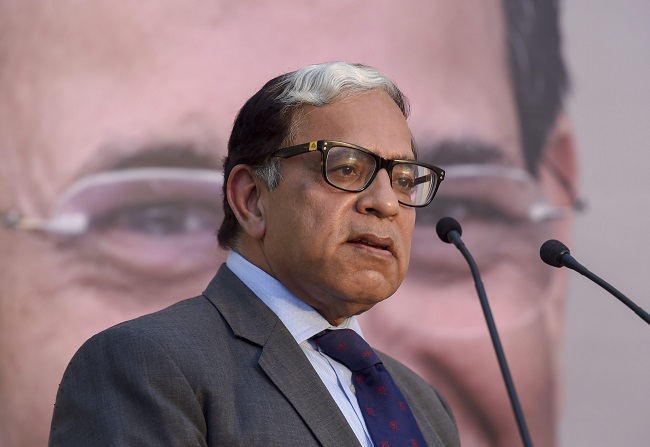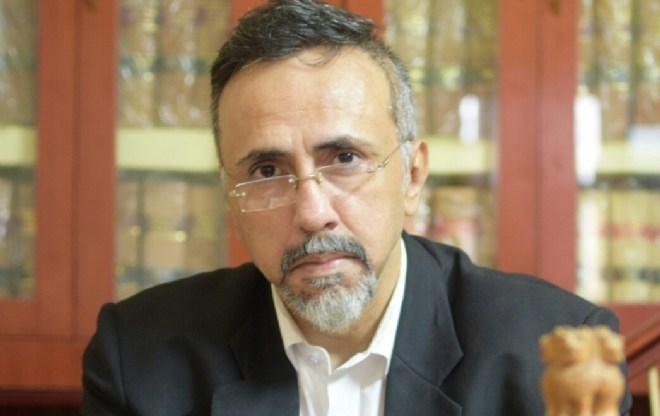Islamic Scholar Syed Rizwan Ahmed blamed the unhealthy association
between Muslim clergy and Muslim intellectuals for pushing Indian Muslims away
from the mainstream. He termed his cousin and actor Naseeruddin Shah’s comments
on “intolerance” as irresponsible and reckless. Rizwan also called for action against
the fake Gau-Rakshaks (cow protectors) to build harmony between Hindus
and Muslims.
Excerpts of the Interview
Q: The debate over ‘rising intolerance in India’ has
cropped up yet again. This ‘intolerance brigade’ has found a fresh breath of
air after Naseeruddin Shah’s recent comment on intolerance. A few people have
even claimed that they feel ‘safer’ in Pakistan than in India. How do you see
this?
Ans: Intolerance in India is the brain child of
Muslim incompatibility to co-exist peacefully with other faiths. After the
bloody Partition (of India) in 1947, Indian leaders, to whichever political
party they belonged, preferred India to be secular. Also, the Hindus of India
did not object to it at that time. That was a rare example of tolerance ever
exhibited by any faith in history. However, the question is what have the
Muslims done to Hindus in return? Sadly, absolutely nothing. And ever since Manusmriti
was rejected, and Hindu laws were codified under modern law, the political
dispensation of Jawaharlal Nehru offered special privileges to Muslims. Since
then, there have been many incidents where Muslims failed to play any
pro-active role, be it the Shah Bano case, or the Kashmiri Pandits when they
were kicked out of their original birthplace, or the rampant and illegal
immigration of Bangladeshis into India. So as time passed, the Hindus started
feeling that they were getting ‘raw deal’ under the guise of secularism and
that was hurting them somewhere down the line. Gradually, that feeling
manifested itself, and now the Hindus have become more articulate, assertive,
vehement which today is being perceived as intolerance.
Today, intolerance in India means a person questioning the
minority communities such as Muslims, or a person holding minorities
accountable for their conduct, or anyone asking them to conduct themselves within
the framework of being an Indian. This is considered intolerant.
For me, there is nothing like intolerance. It is just a
false narrative of the pseudo-seculars and intolerant Muslims. The statement
given by Naseeruddin is reckless and irresponsible. He is just a loose cannon
ball.
Q: How do you view this intolerance or the insecurity
narrative being talked about over the last few years?
Ans: Muslims have become habituated to throwing
tantrums, and being pampered in the name of minorities. The moment someone
starts questioning them over their tantrums, they raise a hue and cry about
‘rising intolerance’.
Q: Being a Muslim yourself, do you believe that Muslims
are not safe in India as several other Muslims have claimed…
Ans: Muslims are only unsafe in one part of India,
i.e. after you cross the Banihal tunnel of Jammu and Kashmir and enter the
Kashmir belt (Kashmir Valley) of the country. Muslims are only unsafe in
nations where Muslims are in the majority. But unfortunately, wherever Muslims
are in the minority, they create such a situation in which they end up being
insecure due to manufactured fault lines in the name of divine superiority and
thus being victimised by ‘others’.
Q: On social media platforms whenever you speak about the
negative side of Islamists or condemn their acts, you are targeted…
Ans: These set of people have forgotten the essence
of Islam. Islam was revealed in the land of ignorance that was Arabia. Islam
was revealed to reform the people of Arabia. These people today feel that Islam
in the form delivered around 1400 years back as the most reformed religion or
faith. For them reformed Islam is no Islam; for them, freedom of expression
does not exist. The doctrine of Ijtihad, meaning application of mind in the
backdrop of Islam to reach a logical conclusion, was shut in the 12th and 13th
century. Since then if someone questions or criticises Muslims, that person is branded
as an apostate or ‘kaafir’ for questioning or criticising Islam.
Q: While the Narendra Modi government claims that Triple Talaq
Bill is the need of the hour, Opposition parties along with some Muslim
patriarchal organisations are opposing the move. What is your opinion?
Ans: Triple Talaq is not a part of Islamic theology. It became part of Islamic culture through executive order, and because of this in most Muslim countries, it has been abolished. 90% Muslim women feel that Triple Talaq is undesirable and most Muslim men feel the same way. But the animosity to Narendra Modi runs so deep in the Muslim psyche that they do not want to be seen to be appreciative of Modi’s stand on Triple Talaq. And this animosity is keeping them silent and they are not supporting the idea to abolish Triple Talaq for they may be seen standing next to Narendra Modi.
The people and the organisations who are saying that Modi is
targeting Muslims and wants to put them in jail, they should hold a press
conference and announce that Talaq-e-biddat ceases to exist in India as
per Sharia also.
They should issue a circular to all the Sharia courts and
submit an affidavit under the same petition of Triple Talaq in the
Supreme Court that as per Sharia also, Talaq-e-biddat ceases to exist.
The moment All India Muslim Personal Law Board does this, the bill shall by
default, become irrelevant. The law shall not move in because the law and
Sharia shall be on the same platform. Thus registration of FIR shall be
infructuous with no Muslim male ever going to jail. No Triple Talaq, no
jail; win-win for all. But they will never do so because they want to end up
showing we made Narendra Modi lose in his endeavour.
Q: It has been more than 70 years since India’s Independence,
but the Muslim community is still considered backward. Who do you think is
responsible for this backwardness of the Muslim community?
Ans: Two major players are responsible for the
backwardness of the Muslim community. One is the Muslim Ulema, and
surprisingly, the other is educated Muslims. No community is educated in
toto. Any race or community which has been reformed, it has been through a
handful of literate people who have the wisdom to see the future.
The problem with Indian Muslims is that the educated class
of Muslims connived with the clergy and did not support the reform within the
community. Had the Muslim intellectual class challenged the community after
Independence and had pushed the community to embrace the mainstream, the
scenario would have been altogether different today. However, the Muslim
intellectuals and clergy are hand in gloves. That is why I say the idea of the
Quran in one hand and laptop in other does not suit my idea of Muslim reform.
I want to add that the political parties who have always
shot at the ‘Right Wing’ using the shoulder of average Muslims, have always
exploited, threatened and made the Muslims realise that the existence of
Muslims and Islam in India is under threat because of Right Wing. It was this threat
perception they inculcated in average Muslims, rather than pulling them into
the mainstream; they pushed them out of the mainstream.
Instead of ironing out creases of doubts and fears from the
minds of average Muslims, the Muslim intellectual class and pseudo-intellectual
parties helped the clergy in pushing the community out of the mainstream in the
name of religious identity.
Q: It is alleged that Indian Muslims find it difficult to say ‘Bharat Mata ki Jai’ and sing ‘Vande Mataram’. Even most of the time Muslim leaders and organisation openly say that we will not chant ‘Bharat Mata ki Jai’ and ‘Vande Mataram’.
Ans: As a Muslim scholar, I see a difference between ‘Bharat’ and that between India / Hindustan. For me, Bharat is not about geographical boundaries; it is about tradition and the Bharatiya ideology. From ‘Satyug’ till date, everything sums up as ‘Bharat’; the thought, civilisation, culture, tradition, language and ancestors.
Muslim clergy and intellectual class feel that the moment
they chant ‘Bharat Mata ki Jai’ or ‘Vande Mataram’, they will
submit themselves to the ideology of Bharatiyata. Instead, they depict
themselves submitting to Arab ideology or the idea of Ummah, which says
that Islam is one community which has nothing to do with isolated nationalism.
Q: It has been alleged many a time that the Modi government
is against Muslims. How true is that?
Ans: Any person who shall not pamper the Muslim
community or ignore their tantrums shall be perceived as anti-Muslim.
Q: What is your opinion about the Ram Mandir (Temple)
at Ayodhya?
Ans: About Ram Mandir, I want to tell my
Muslim brethren that as a responsible minority, we should not get into an
argument on ‘Where was Sri Ram born?’ The day archaeological evidence proved
beyond doubts that a man-made structure existed under Babri Masjid, that
was a beautiful moment for the Muslims to withdraw from that piece of land
leaving the Hindus to decide where Ram was born or whether Ram Mandir is
to be built there or not.
Acknowledging the fact that this land belongs to some other
faith, Muslims should have unconditionally withdrawn from the disputed space of
2.77 acres, asserting for this being last such dispute.
Q: What is your
opinion over RSS (Rashtriya Swayamsevak Sangh)?
Ans: How RSS came up? In 1906, Muslim League comes up
with two-nation theory; 1909: Separate electorate for Muslims; 1917: Khilafat
Movement; 1919-1924: Riots/ Mopla Massacre; 1925: RSS.
From 1947 to 1962-1965 War and the natural calamities India has
faced, RSS has always stood up at the hour as an organisation. And when it
stood up, it did not discriminate between Hindus and Muslims. On only one
occasion—Emergency (1975), Muslims and RSS fought together shoulder to shoulder
against the political dispensation. But surprisingly after Congress came to power,
India witnessed severe communal riots that subsequently created enmity between
RSS and the Muslims, which is still alive. The moment average Muslim starts
developing an understanding and compatibility with RSS, the whole idea of
pseudo-secularism will fall flat on its face in the country on which several political
parties have been enjoying undisputed power for the last 70 years. Hence, they
manufacture rift between RSS and Muslims regularly.
Q: What is the solution to ensure Hindu-Muslim harmony in
India?
Ans: In the last four years, the primary reason behind the rift between Hindus and Muslims are the Muslim clergy, pseudo-secular parties, Muslim intellectual class and fringe Hindutva elements. A very wrong perception about India has been created globally and also in the psyche of nationalist Muslims because of some deaths in the name of Gau-Raksha (cow protection). The BJP government should have been more impartial and acted strictly against the fake Gau Rakshaks or those who are glorifying the killings in the name of Gau Raksha.
(this interview was first published in Organiser Weekly)












